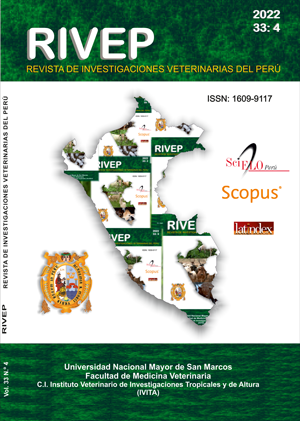Genetic diversity in Mexican creole donkeys
DOI:
https://doi.org/10.15381/rivep.v33i4.21943Keywords:
genetic marker, AMOVA, Hardy-Weinberg equilibrium, linkage disequilibrium, heterozygosityAbstract
The aim of this study was to evaluate the genetic diversity of the Mexican criollo donkey with SNP-type genetic markers. Sixteen individuals (eight males and eight females) were randomly sampled and genotyped using the GGP Equine 70K chip (71 947 loci). Within chromosome the polymorphic SNPs were identified, determining the expected (He) and observed (Ho) heterozygosity, polymorphic information content (PIC), the fixation index (FIS) and the Hardy-Weinberg equilibrium (HW). Linkage disequilibrium was assessed based on the correlation (r2) between frequencies across loci. An analysis of molecular variance (AMOVA) and a cluster study were performed to infer the number of clusters (k). It was found that 3579 loci (4.9%) presented genetic variability, but 24.9% presented HW disequilibrium (p<0.05). Across chromosomes, the number of polymorphic loci ranged from 50 to 269 with a mean of 115. The (within chromosome) means for PIC and FIS ranged from 0.222 to 0.267 and -0.392 to -0.208, respectively. In all chromosomes Ho was superior to He. For r2, the mean values within chromosome were greater than 0.10; the optimal k corresponded to 2. In the AMOVA, the genetic variability within individuals explained 67%. The SNPs identified as polymorphic make up a first panel of genetic markers for the Mexican creole burro, and the estimated genetic variability can be used in development and conservation schemes.
Downloads
Downloads
Published
Issue
Section
License
Copyright (c) 2022 Joel Domínguez-Viveros, Felipe Alonso Rodríguez-Almeida, David Alonso-Alcalá, Carlos Barreda-Elizondo, Juan Manuel Ramírez-Reyes, Efreen García-Robles, Guadalupe Nelson Aguilar-Palma

This work is licensed under a Creative Commons Attribution 4.0 International License.
AUTHORS RETAIN THEIR RIGHTS:
a. Authors retain their trade mark rights and patent, and also on any process or procedure described in the article.
b. Authors retain their right to share, copy, distribute, perform and publicly communicate their article (eg, to place their article in an institutional repository or publish it in a book), with an acknowledgment of its initial publication in the Revista de Investigaciones Veterinarias del Perú (RIVEP).
c. Authors retain theirs right to make a subsequent publication of their work, to use the article or any part thereof (eg a compilation of his papers, lecture notes, thesis, or a book), always indicating the source of publication (the originator of the work, journal, volume, number and date).



